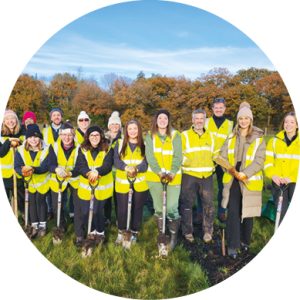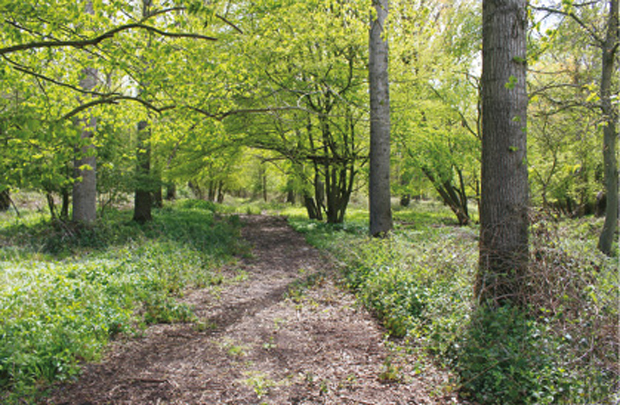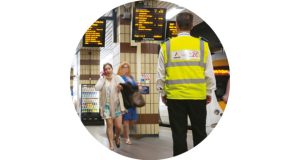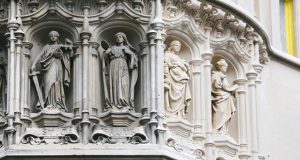MAKING CHANGE FOR NATURE
The scheme is primarily designed for local and native wildlife – with rewilding, nature gain and carbon sequestration driving the project. With the assessments now in place, the project has systemically created and improved habitats and has dynamically adjusted to conditions while working towards meeting the goals created by a team of in-house landscape architects and ecologists.
 The first phase of habitat creation and enhancement works began in winter 2021 in line with planting season, with the symbolic planting of ‘First Avenue’ to mark COP26. This included 26 native trees, all of which were dedicated to UK Environmental Heroes. This kickstarted a series of new habitats including scrub mosaic, species-rich grassland, ponds, and orchards. Over the following years this has included:
The first phase of habitat creation and enhancement works began in winter 2021 in line with planting season, with the symbolic planting of ‘First Avenue’ to mark COP26. This included 26 native trees, all of which were dedicated to UK Environmental Heroes. This kickstarted a series of new habitats including scrub mosaic, species-rich grassland, ponds, and orchards. Over the following years this has included:
- 5,000 native trees planted. This importantly included the planting of 21 species and shrubs that enhanced a 1,000m section of native hedgerow and is strengthening connectivity with existing hedges and trees.
- Early preparation and seeding of the first phase of seven acres of species-rich grassland to create new habitats, followed by the seeding of 106 acres of nutrient-reduction grassland.
- Five new ponds were created, with a focus on supporting Great Crested Newts and the restoration of three woodland ponds.
- 750m of native hedgerow were planted, connecting areas, and providing food, shelter, and security for native species.
- A partnership with the Environmental Agency to enhance and restore an area. This includes a SUDS (Sustainable Urban Drainage System) scrape and creating a new ditch diversion.
Phase one also involved woodland creation and completing the restoration of an ancient woodland on site, which included regenerating native hedgerows, supplemental planting and creating a wildflower meadow and large-scale native woodland creation. This included:
- In-house professional woodland planting, completed in consultation with Forestry England, with the first phase creating 50 hectares of native broadleaf trees, with approximately 100,000 trees.
- The planting of 5,000 native trees and shrubs, to create a linear, biodiverse habitat. The planting will form a nature corridor, linking various parts of the site so wildlife can move easily between them.
- Registration with the Woodland Carbon Code to assure the quality assurance standard for woodland creation projects in the UK.
- Grass seeding to planting areas to act as ground cover and support weed management sward.
- Installing 3km of deer and rabbit fencing to support and protect young trees, allowing them to establish.
MEASURING BNG AND SPECIES POPULATION
While the establishment of woodland and the impact of the carbon sequestration is part of a longer-term plan at Wildfell, as the project approaches its fifth year, it is already seeing considerable gain, in line with DEFRA metrics.
In spring 2022, Ground Control ecologists conducted species-specific surveys for great crested newts, bats, breeding birds, hazel dormice, reptiles, and BAP mammals (UK Biodiversity Action Plan priority species). This baseline information creates a picture of the populations on site, including where their home ranges are and whether these species are breeding. Understanding this will inform potential habitat enhancements, including the provision of hibernacula and management prescriptions for the habitats.
In the summer of 2022 ecology reports discovered seven species of bat (including Barbastelle and Natterers – relatively scarce species in Essex), Great Crested Newt, Common Lizard, Grass Snake, 47 species of bird (including one Red Kite) and active nesting Owl, Raven, Mallard, Moorhen and Starling. Along with the first sighting of Otter on the banks of the River Pant, four active Badger sets, Hare, Rabbit, Fox, and Grey Squirrel.
In August 2024, five species of bumblebee were spotted on a community bee walk led by the Bumblebee Conservation Trust, including a rare species called the brand-banded carder bee (Bombus humilis).
The significance of these ecological gains will increase as the project continues and will indicate whether the new measures are working and are in line with the early positive signs.
Wildfell is collaborating with wild plant conservation charity Plantlife, the Royal Botanic Gardens Kew and the Bumblebee Conversation Trust to conduct surveys and research. This expert input will inform the project’s habitat creation and management proposals for plants, fungi, and pollinators. As part of this work, five bee boxes have been set up on site to monitor solitary bees.





